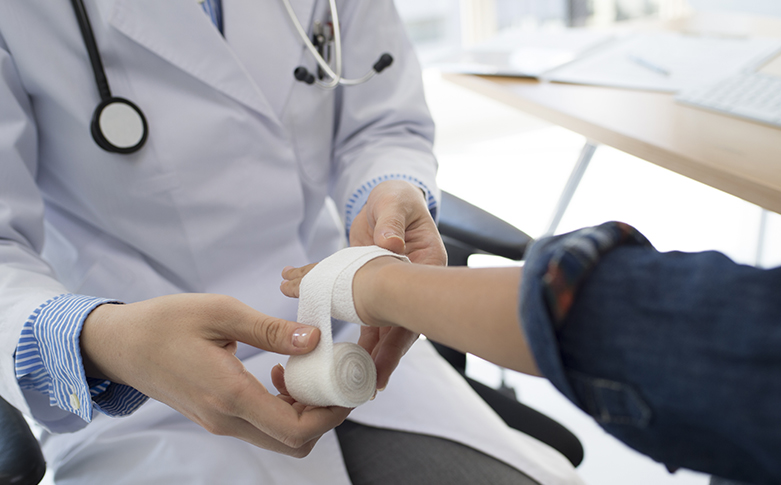 “What do you call a nurse with a bad back? Unemployed!” That famous line from the Showtime hit Nurse Jackie might be funny—if it weren’t so true. “The job with the highest rate of back pain for men is steelworker; for women, it’s a nurse,” says Edgar Ramos Vieira, PhD, a risk assessment and musculoskeletal injury prevention researcher at the University of Alberta in Edmonton, Alberta, Canada, in the Spring 2010 issue of Scrubs. Studies in countries around the world have found the incidence of back pain in nurses to be anywhere from 57 to 77 percent.
“What do you call a nurse with a bad back? Unemployed!” That famous line from the Showtime hit Nurse Jackie might be funny—if it weren’t so true. “The job with the highest rate of back pain for men is steelworker; for women, it’s a nurse,” says Edgar Ramos Vieira, PhD, a risk assessment and musculoskeletal injury prevention researcher at the University of Alberta in Edmonton, Alberta, Canada, in the Spring 2010 issue of Scrubs. Studies in countries around the world have found the incidence of back pain in nurses to be anywhere from 57 to 77 percent.
Nurses like Seth-Deborah Roth are living proof. “I was working in special surgery, lifting drills and heavy equipment while wearing a lead gown, when I felt a sharp twinge,” recalls Roth, who 20 years later still deals with flare-ups in the lumbar region. Lifting patients can be another prime cause for that first spasm. What’s more, Vieira and his colleagues found that pushing, pulling and reaching can also lead to injury, as can standing in an awkward position while assisting a patient, excessive repetition and staying in the same position for a long time.
Back woes aren’t just a pain for you—they also plague everyone in your care. “When your back hurts, you can’t be there for your patients in the way you want to,” says Joyce Murray, who wound up with a herniated disk from years of wear and tear on the respiratory floor. So, yes, back pain often comes with the job, but it doesn’t have to.
Think Before You Lift
It’s no surprise that orthopedic nurses, who frequently transfer patients, and ICU nurses, who constantly turn and boost patients up when they slide toward the foot of the bed, have the greatest incidence of back pain. That’s why it’s crucial to think before you lift so you can accomplish even the most everyday tasks in the safest possible way. If, for instance, a patient has slipped down in bed, rather than struggle to pull him back up, lower the headboard and use a slide sheet to make repositioning easier. Or if turning a patient, reduce damage on your own body by flexing the patient’s knees and hips and using his thigh as a lever. When making a lateral transfer, ensure that both surfaces are even, and use lowering and raising mechanisms if available. Always, always, always remember this: When lifting equipment or anything else that’s heavy, rather than bending at the waist, bend your knees and use your legs to raise it. It’s critical to become familiar with the types of lifting you need to do and how to do them correctly. Soon enough, they will become habit—no thinking required.
Keep in mind you’re a nurse, not a forklift—so get help when faced with a literally heavy task. If a mechanical lift is available, use it. If not, says Vieira, ask the patient to help if she is able by moving her own body on a count of three or, as Murray advises, “Get the team behind you.” This is especially important if the patient is overweight. While it’s easy to get caught up in the moment and just do the work yourself without the proper equipment, that’s just self-sabotage, which will only lead to injury and, in the end, won’t help anybody. If back pain knocks you out, you’ll be little good to anyone.
Lifting isn’t the only cause of back pain. Steer clear of other moves that can get you in trouble, like twisting while assisting patients, moving tools and repositioning furniture. If you find you have to push excessively to get something (or someone) to move, stop and find a way to accomplish your goal with less difficulty, even if that means calling in reinforcement or taking the time to use equipment. Avoid awkward positions, and when you find yourself in one, don’t hold it for more than a second, slowly easing yourself out of it.
There are several other defenses against back pain. One study by Vieira showed an association between back pain and smoking—another reason to quit! It’s also well known that being overweight can contribute to back problems—another reason to combat fat! The best preventive measure of all? Being fit. “When you’re limber and your core muscles are strong, you have more control and that can help you prevent injury,” says Melanie Kinchen, MD, a spokesperson for the American Academy of Orthopedic Surgeons who’s in private practice in Whittier, Calif. Among the best forms of exercise for preventing back pain are Pilates, yoga and other stretching and core-strengthening activities. Even a simple routine of pelvic tilts and lifts, hamstring stretches, crunches and the cat-and-camel move, done for just a few minutes two or three times a week, will make a difference.

















